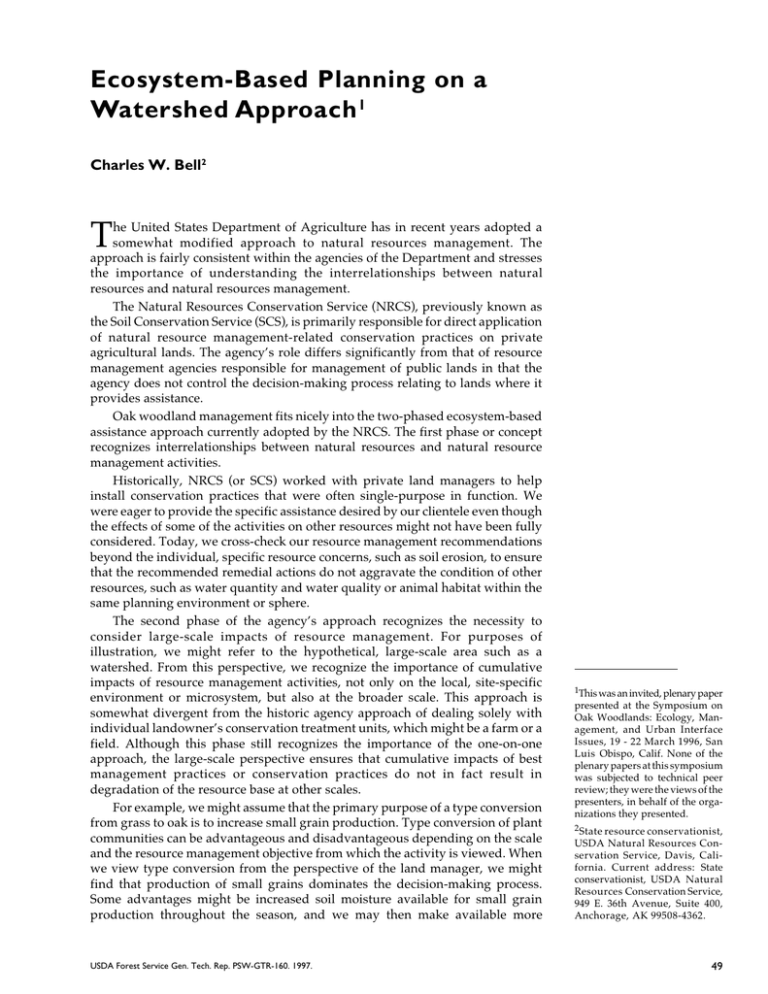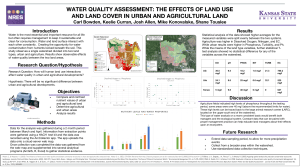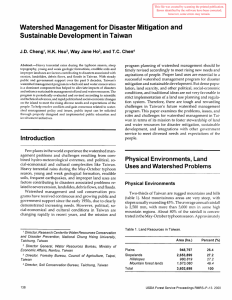T Ecosystem-Based Planning on a Watershed Approach Charles W. Bell
advertisement

Ecosystem-Based Planning on a Watershed Approach 1 Charles W. Bell2 T he United States Department of Agriculture has in recent years adopted a somewhat modified approach to natural resources management. The approach is fairly consistent within the agencies of the Department and stresses the importance of understanding the interrelationships between natural resources and natural resources management. The Natural Resources Conservation Service (NRCS), previously known as the Soil Conservation Service (SCS), is primarily responsible for direct application of natural resource management-related conservation practices on private agricultural lands. The agency’s role differs significantly from that of resource management agencies responsible for management of public lands in that the agency does not control the decision-making process relating to lands where it provides assistance. Oak woodland management fits nicely into the two-phased ecosystem-based assistance approach currently adopted by the NRCS. The first phase or concept recognizes interrelationships between natural resources and natural resource management activities. Historically, NRCS (or SCS) worked with private land managers to help install conservation practices that were often single-purpose in function. We were eager to provide the specific assistance desired by our clientele even though the effects of some of the activities on other resources might not have been fully considered. Today, we cross-check our resource management recommendations beyond the individual, specific resource concerns, such as soil erosion, to ensure that the recommended remedial actions do not aggravate the condition of other resources, such as water quantity and water quality or animal habitat within the same planning environment or sphere. The second phase of the agency’s approach recognizes the necessity to consider large-scale impacts of resource management. For purposes of illustration, we might refer to the hypothetical, large-scale area such as a watershed. From this perspective, we recognize the importance of cumulative impacts of resource management activities, not only on the local, site-specific environment or microsystem, but also at the broader scale. This approach is somewhat divergent from the historic agency approach of dealing solely with individual landowner’s conservation treatment units, which might be a farm or a field. Although this phase still recognizes the importance of the one-on-one approach, the large-scale perspective ensures that cumulative impacts of best management practices or conservation practices do not in fact result in degradation of the resource base at other scales. For example, we might assume that the primary purpose of a type conversion from grass to oak is to increase small grain production. Type conversion of plant communities can be advantageous and disadvantageous depending on the scale and the resource management objective from which the activity is viewed. When we view type conversion from the perspective of the land manager, we might find that production of small grains dominates the decision-making process. Some advantages might be increased soil moisture available for small grain production throughout the season, and we may then make available more USDA Forest Service Gen. Tech. Rep. PSW-GTR-160. 1997. 1This was an invited, plenary paper presented at the Symposium on Oak Woodlands: Ecology, Management, and Urban Interface Issues, 19 - 22 March 1996, San Luis Obispo, Calif. None of the plenary papers at this symposium was subjected to technical peer review; they were the views of the presenters, in behalf of the organizations they presented. 2 State resource conservationist, USDA Natural Resources Conservation Service, Davis, California. Current address: State conservationist, USDA Natural Resources Conservation Service, 949 E. 36th Avenue, Suite 400, Anchorage, AK 99508-4362. 49 Bell Ecosystem-based Planning on a Watershed Approach consistent management strategies across a continuous landscape as opposed to a grass-oak mix. When we view this same objective from the perspective of interrelationships of resources and impacts beyond the site, several other considerations become evident. And some of these might be considered advantageous and some disadvantageous. Some examples of the latter might be reduced habitat diversity; accelerated soil movement and associated erosion due to excessive soil moisture in the upper soil profile; reduced shade and riparian areas and, hence, increased surface water temperatures at the site and watershed levels. Surface and subsurface water may move downslope more rapidly because of reduced interception and evapo-transpiration. From the standpoint of plants, reduced micro-environment and diversity decreased complexity in the ecosystem. From this discussion, it should be fairly evident that meeting the landowner’s objective of increased small grain production without considering the impacts on other natural resources could result in an entirely different suite of land management activities. Beyond the site, it is quite possible that the cumulative impacts of our best conservation strategies might in fact degrade critical resources which we are trying to improve. For example, we might agree that the tolerable soil loss for a soil map unit might be 5 tons per acre per year at the site level. That amount of soil loss, when accumulated throughout the watershed, might in fact be degrading a critical surface water body. It is not enough to make decisions based upon the condition or trend of natural resources at the site level alone. Multiple land-use strategies must also be recognized at the larger scale. For example, it is not logical to work to improve nutrient management strategies in one sector or land use within a watershed without considering the contributions of other sectors, for example, urban areas. We need to identify the sources, convince all land-use sectors within the watershed that they have a stake and a hand in natural resource conditions in the watershed, and help them to develop remedial measures. The critical success requirement for this modified, multi-resource and multiscale approach to resource management is intensified cooperative working relationships with other agencies, institutions, and organizations. Collectively, we can bring to the table areas of expertise, technical and financial assistance, and natural resource management perspectives that ultimately benefit all natural resources in California. 50 USDA Forest Service Gen. Tech. Rep. PSW-GTR-160. 1997.






